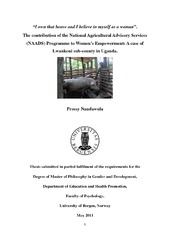| dc.description.abstract | The government of Uganda, in its endeavours to reduce poverty by empowering women, has since 2001 been implementing the National Agricultural Advisory Services (NAADS) programme. NAADS is aimed at enhancing rural livelihoods, as well as increasing the proportion of market oriented production. This is sought achieved through empowering farmers, particularly the poor and women, to demand and shape agricultural advisory and information services. However, Uganda being a patriarchal society, women's participation in commercial agriculture is still hampered by their triple roles' and lack of control over production resources like land. This study explores the contribution of the NAADS programme to women's empowerment in Uganda. The study is qualitative and based on 20 key informants and 13 background interviews, in addition to participant observation. The informants are beneficiaries and implementers of the NAADS programme of Lwankoni sub-county in Rakai District, Uganda. Through the empowerment theory concepts of resources, agency, achievements, choice and power, along with Kandiyoti's concept of bargaining with patriarchy, the study reveals varying levels of empowerment among the female beneficiaries of the NAADS programme. The less empowered had, at the time of the fieldwork, achieved little in terms of control over material resources like land, which limited their agency. In turn, their agency - which usually tended towards the passive and minimal - was reflected in their choices, which were effective rather than transformative. The agency of some women, especially the married, was also limited by the patriarchal bargains' and the overarching power over' them by their in-laws, husbands and the community. However, the study also reveals that some female beneficiaries have attained some degree of empowerment. Although they have not been able to fully reach what Longwe (1991) refers to as the highest level of empowerment due to the existence of patriarchal bargains, the study argues that the changes that have occurred in the lives of the female beneficiaries within 4 to 7 years after joining NAADS indicate that they may be in the process of transformative empowerment. The study, therefore, concludes that the NAADS programme has contributed to women's empowerment, and some of it is transformative, despite the fact that NAADS' official definition of empowerment, as well as the majority of the implementers' and husbands' understandings and perceptions of the concept, indicate that empowerment is not really a priority of the programme. The results of this study clearly indicate a need for the government to revise the NAADS goal of women's empowerment while at the same time designing strategies that increase women's access to water and control over land. | en_US |
